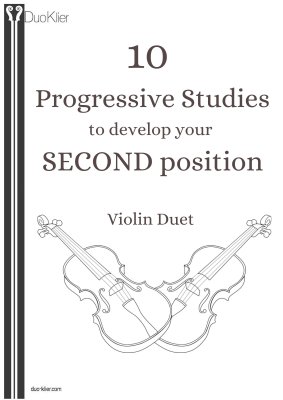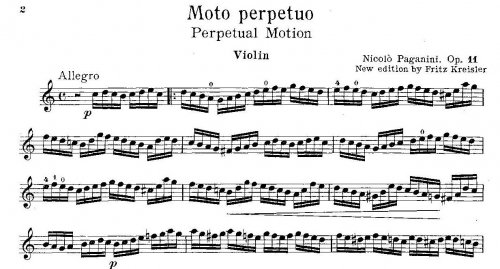I've always considered Perpetual Motions one of the most beneficial pieces to learn from a technical point of view. They help develop left hand agility, bow ease, stamina, and most importantly, they have to be played in a completely relaxed way.
I've come up with a top-10 list ordered by difficulty, although that's hard to say because like Bach Sonatas and Partitas, Kreutzer Studies or Mozart Concertos, they can be tackled at very different stages of learning.
2nd violin accompaniments to all the pieces can be found here
1. S. Suzuki: Perpetual Motion from Book 1
Not a Suzuki teacher myself but I thought this should be the first one. Only one finger pattern involved and the octave range make it possible to transpose to other keys. Notes can be doubled or quadrupled (and why not tripled!) for a quicker bowing action.
2. C. Bohm: Moto Perpetuo, No.6 from Suite III
Much longer and complex than Suzuki's, using different finger patterns, accidentals and quick string crossing. It can be entirely played in first position.
3. E. Jenkinson: Elves Dance
Requiring just a bit of 3rd position (or extensions) this lovely piece is a MUST of the intermediate player repertoire. I haven't found a single student who doesn't love it!
And our Two Violins arrangement:
4. C. Bohm: Perpetuo Mobile, No.6 from Little Suite
Another delightful little piece, with much more use of the 3rd position and some bits that can be played in 4th and even 5th positions.
Our arrangement for Two Violins:
5. C. Bohm: The Rain, No.4 from 6 Miniaturen Op.187
The third and last of Bohm's pieces, the trickiest mainly because of the constant use of higher positions. The original edition suggests it can be played with either single or double spiccato notes per semiquaver.
6. F. Bridge: Moto Perpetuo
From this point on I'd say the pieces are not written specifically for children, although can by played by them of course! This less known piece by the English composer Frank Bridge offers enough challenges for the advanced player, not only the fingers agility all these pieces require but also some double stopping and a fun chromatic glissando.
7. F. Ries: Perpetuum Mobile, from Suite No.3, Op.34
This is a good example of what I mentioned earlier, a piece that can be tackled at very different points. When you are an advanced student:
.. or when you are Nathan Milstein:
8. O. Nováček: Perpetuum Mobile
One of the favourite encores of all times, not only H. Szeryng (below) used to perform it frequently, also Perlman, Menuhin, Heifetz, Milstein…
9. N. Paganini: Moto Perpetuo Op.11
One of the best known perpetual motions here performed by Y. Menuhin:
10. N. Rimsky-Korsakov/Heifetz: The Flight of the Bumblebee
Final piece of the list and possibly the most popular of all, performed on many other instruments: trumpet to double bass. I leave you here my favourite version, Yo-Yo Ma and Bobby McFerrin:
…and our arrangement for Two Violins:
There are many more out there! For young violinists, first to come to my mind are two little pieces by Sheila Nelson and Mary Cohen. For grown-ups, Joseph Suk's Burleska and the third movement of Barber's violin concerto.
Which one is your favourite one? Would you like to see others on the list? Please leave a comment and share your perpetual motion knowledge!





